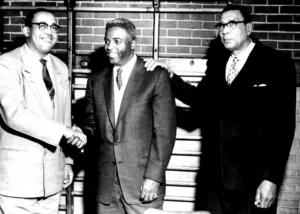
“42” (Jackie Robinson), “Rocketman” (Elton John), “A Beautiful Day In The Neighborhood” (Fred Rogers), “Bohemian Rhapsody” (Freddie Mercury) “I Wanna Dance With Somebody” (Whitney Houston), “When They See Us” (Kevin Richardson, Antron McCray, Yusef Salaam, Korey Wise, and Raymond Santana), and so many more! These are just a few of the many documentaries and projects based on life stories that have been produced.
These motion pictures, biopics, and other real life-based projects have triggered a renewed discussion in the industry about the issue of life story rights, or “life rights” for short.
What are Life Rights?
In a nutshell, life rights are thoughts, observations, recollections, reactions, and experiences surrounding, arising out of, and concerning events, incidents, situations, and experiences that have occurred throughout a person’s life.
In other words, it’s the non-public events that happen in someone’s life. These rights may need to be acquired from the subject person just like any other property right before being incorporated into a project. The following are examples of projects where acquiring life rights needs to be considered:
- A motion picture studio that wants to produce a documentary on a person that includes intimate details.
- A television network that wants to create an authorized biography movie, or biopic, that tells the story of a person from his or her perspective.
- A reality show that features a person’s daily life experiences on camera.
- An author who is writing a screenplay, teleplay, book, magazine article, short story, stage play, essay, or treatment about a person’s life.
- The producer of a media project that will incorporate a person’s life story, such as a music video, commercial, mobile application, video game, online content, or virtual reality experience.
Do Life Rights Need To Be Acquired?
There is case law that says that in certain cases life rights do not need to be acquired because of the First Amendment; however, it is best if a producer analyzes his or her specific situation and make an informed decision. For instance:
- If a project is based on the story of a person and contains intimate details that may not be public, then a producer likely needs to acquire life rights.
- If a project is based on a previously written story about a person, then a producer needs to obtain a license from the author of the work and may also need to acquire life rights from the person.
- If a project is strictly based on non-fictional facts and events that a producer obtained solely through researching public materials, then he or she may not need to acquire life rights from a person.
- If it is unclear whether life rights need to be acquired, then a producer may want to avoid the risk of being sued and acquire life rights from a person.
Keep in mind, there are clear benefits in securing life rights from a subject person regardless of the legal analysis, such as it may encourage the person to give a producer more substantive information to enhance the project and it will reduce the risk of a potential defamation or invasion of privacy claim by the person (avoiding a significant amount of time and legal fees).
Also, having an agreement in place with a person will make it easier for a production company to obtain errors and omission insurance.
How Are Life Rights Acquired?
Typically, life rights are acquired by either a Purchase Agreement or an Option to Purchase Agreement.
Purchase Agreement
Just like purchasing any other type of property, a producer can buy a person’s life rights on whatever terms and conditions are agreed to by the parties.
Purchasing the rights may be the best decision if a producer has already secured financing, attached sought after talent, or otherwise developed the project where it is ready to move forward quickly.
The following are key terms to consider include:
- Purchase Price
- Contingent Compensation
- Rights Granted
- Derivative and Alteration Rights
- Cooperation between the writers and person
- Portrayal Rights
- Participation with Publicity for the Project
Option to Purchase Agreement
Just like obtaining option rights for any other type of property, a producer can secure an option to purchase the life rights for a certain period.
A producer will typically pay the person a nominal fee to have time to write the literary work (i.e., screenplay), secure financing, attach talent, and ultimately purchase the rights before the option expires.
The following are key terms to be considered:
- Term (Length) of the Option
- Option Fees
- Development Rights
- Reversion of Rights
- Representations, Warranties, and Indemnification
- Purchase Price
Other provisions may apply to this transaction, such as securing other rights related to name and likeness uses, screen credits, press, and promotional guidelines, holdbacks for other projects, social media campaigns, and what happens to the rights if the Company abandons the project before it is released.
In short, a producer should first determine whether it is necessary to acquire the life rights from a person early in the development of a project.
If it is in a producer’s best interest to do so, the following are some best practices to follow:
- Acquire life rights from a person by entering into either a Purchase Agreement or Option to Purchase Agreement.
- Obtain required written consents and releases for all people depicted in the project.
- Ensure that the portrayals of all people in the project are true and accurate to avoid libel and defamation claims.
- Avoid being overly intrusive into a person’s personal life even if an agreement is in place to avoid an invasion of privacy claim.
Always protect your work. We offer Affordable agreements packages.
Documentary Independent Film Makers Agreements
Reality Television Digital Production Agreements
Disclaimer: Nothing stated in this blog is intended to be, or shall be considered, legal or other professional advice. To properly analyze the issues raised in this piece, you need to engage a competent attorney to assess your specific situation. Also, note that all of the disclaimers to this site also apply.


